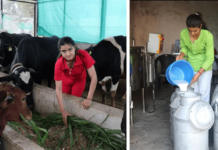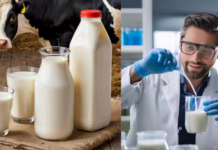New Delhi, January 29, 2021: Dairy farmers should aim to feed a 15% crude protein concentrate ration to freshly calved dairy cows, according to Teagasc nutritionist Joe Patton.
“Ingredients must be of the highest quality. A typical ratio would comprise an equal mix of a high-quality cereal: maize or barley; fibre: hulls or beet pulp and protein: distillers or soya,” he said.
“Minerals must also be included: calmag; salt; limestone; maybe a bit of phosphorous and trace elements. The mineral component of the ration will stay the same, irrespective of the other components used.”
Patton made these comments during a recent Teagasc Dairy Edge podcast.
He continued:
“This type of concentrate will deliver adequate cow performance on those farms that have an adequate grass supply at the present time.”
Limited Grass
On farms where grass is limited and silage is the main forage source, a 16% concentrate ration should be fed.
“This can be achieved by upping the soybean level, specified for a 15% crude protein ration up to a 10% inclusion rate,” Patton explained.
“The extra soya makes up for the reduced protein content of silage, relative to grass. “If farmers stick to these principles and maintain daily feeding rates of between 3kg and 5kg, depending on the availability of grass or silage, then it should be possible to get through the spring period.
Beyond that it becomes a case of talking about grass and grazing management.
Cows
The Teagasc nutritionist also confirmed that all cows will be in a state of negative energy balance for a period of time after calving according to the reports published in agriland.ie.
“It takes 10 weeks for cows to reach peak intakes. However, peak milk output will happen before this,” he said.
Previously the thinking was that we should try to get as much feed into a freshly calved cow as possible.
“However, we have moved away from that thinking now, opting to ensure that cows have access to clean, high-quality forages at all time with feed rates built up on a gradual basis,” Patton added.
“This approach avoids digestive upsets. Pushing cows too hard tends to accentuate the challenge of negative energy balance, thereby causing more problems than it could ever solve.”
Patton explained to the webinar that cows will probably start to turn the corner, from a negative energy perspective, around four weeks after calving.
“It is also apparent that higher EBI (Economic Breeding Index) cows, because of their genetics, will start to turn the corner that much earlier,” he said.
“They will start cycling that little bit sooner and they will start to put on weight that little bit sooner.”

































